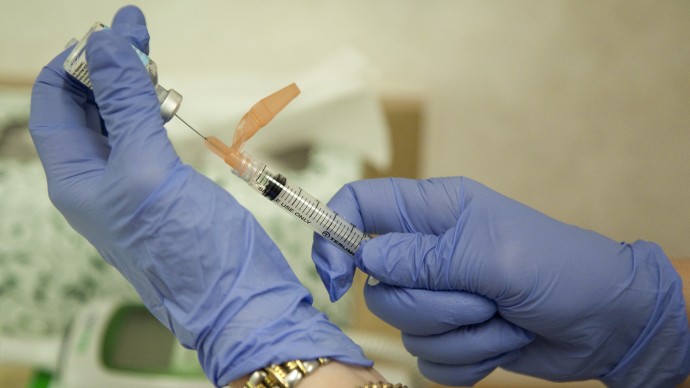
(MintPress) – Should you get the flu shot?
It’s a question that draws heated discourse from the widest of polarities. “It makes you sick,” some will say. Others sing its praises while detractors claim it just doesn’t work. But as the Center of Disease Control and Prevention (CDC) spends every spring speculating on the most dangerous strains of flu, it spends equal time urging the public to be vaccinated. The annual public relation-like campaign is a microcosm of the divide between cynics and believers that could potentially result in an epidemic or pandemic.
During the mid-1990s, use of the influenza vaccine became more widespread than at any other time in history. Since then, the flu has become big business for pharmaceutical companies in the United States. In 2009, the debate on the merits of the flu shot took off after the discovery of Swine Flu, caused by the H1N1 virus. According to the European Center for Disease Prevention and Control, 14,286 people died as a result of the virus – registering the virus as the most recent flu pandemic since the Hong Kong Flu outbreak.
As the CDC raced to identify the virus, American pharmaceutical companies may have been the biggest beneficiaries of the pandemic. As a separate vaccine from the traditional seasonal flu shot, the H1N1 vaccine generated $1.5 billion in revenue for companies such as Sanofi-Pasteur, Glaxo Smith Kline and Novartis. Globally, the vaccination market generated $20 billion on the Swine Flu vaccine alone.
The balance between a for-profit pharmaceutical industry and vaccinating a population have made skeptics leery of the motivation and effectiveness of the shots – going as far as claiming they are a marketing ploy that do more harm than good. Dr. Dan Harper, a family practitioner in California, says the risk posed by the season shot far outweigh the benefits. Harper says that ingredients found in the flu shot, such as thimerosal, contain compounds that can impair the neurological system. He also subscribes to the theory that the flu shot is part of the realm of vaccines that cause neurological and developmental disorders.
“Someone who gets vaccinated could say, ‘Well the flu didn’t kill me.’ But when you’re sitting there with Alzheimer’s, ALS, MS or you’re watching your kid develop seizures or become autistic you’re going to kick yourself in the butt for allowing your child or you yourself receiving it,” Harper told Mother Nature Network. “It’s frightening to me the stuff they put in the vaccine. These diseases, at least in part, are because of vaccines.”
Researchers battle misconceptions
Harper provides an outlier perspective that the CDC has long refuted from challengers over the years. Since the turn of the century, the CDC has backed the flu shot as not only a means of added immunity for the individual, but a benefit to society to help quell the risk of widespread outbreaks. According to the CDC, the most common misconceptions surrounding the flu shot are that it contains dangerous chemicals and is made up of a flu virus that can make you sick.
Many of the chemicals in the flu shot pointed out by detractors are at miniscule levels, meaning they pose no tangible threat to humans, the CDC says. The CDC acknowledges the existence of thimerosal in seasonal flu vaccines, but says critics like Harper are being alarmists. The biggest misconception the CDC stresses? The flu shot does not have the capacity to give someone the flu.
In the making of the vaccine, the CDC and researchers identify three of what they feel to be the most prevalent and dangerous strains of flu for that year. Pharmaceutical companies then build vaccines with dead viruses of those strains, meaning they are not capable of making people ill.
“The viruses contained in flu shots are inactivated, which means they cannot cause infection. Flu vaccine manufacturers kill the viruses used in the flu shot during the process of making vaccine, and batches of flu vaccine are tested to make sure they are safe,” the CDC said. “In randomized, blinded studies, where some people got flu shots and others got saltwater shots, the only differences in symptoms was increased soreness in the arm and redness at the injection site among people who got the flu shot.”
Dr. Greg Poland, a practitioner at the Mayo Clinic and research member of the Infectious Disease Society of America, says it is medically impossible for the flu shot to make people ill. What it may do is preoccupy your immune system, making you susceptible to other infections if you are not healthy or not consuming a healthy diet.
“The vaccine is taken from two of the hundreds of different proteins that compose an influenza virus,” Poland said. “Taking merely two surface proteins off the virus does not mean it’s live; there’s no organism there … it’s not possible to cause infection or disease with it … the flu shot does not give you the flu.”
Doctors and researchers say that the flu shot was created more with reducing the effects of a pandemic and less with an individualistic attitude in mind. Participation of the population in the flu shot is less than half, with 42 percent of the U.S. population receiving the vaccine. Dr. Elizabeth Baorto, a director of pediatric infectious disease, says that vaccination against the flu is an “altruistic act” that protects the individual, as well as the community around them. Many physicians say that protection is even more important for those working in health care, where flu vaccination rates were 67 percent in 2011.
“I believe that the immunization of the health care provider community is both an ethical and professional responsibility,” said Dr. William Schaffner, former president of the National Foundation for Infectious Diseases. “It is for two reasons: The first and most important is a patient safety issue, so we do not transmit our influenza infection to our patients. The other reason is, when influenza strikes, we need to be vertical, not horizontal. We need to be ready to provide health care during that period of great community stress.”
What can be questioned? The effectiveness
Because the CDC and researchers take educated guesses as to what strains of flu to build the vaccine around, the efficacy of the shot is often in question. This year, a University of Minnesota study found that seasonal flu vaccines may not offer the level of protection against the virus that many developers and consumers assume. The study, over the course of three years, found a 59 percent protection rate among vaccinated adults. Despite the findings, researchers behind the study said the season flu shot is still the best defense on the market.
“We believe the current influenza vaccine will continue to have a role in reducing influenza morbidity until more effective interventions are available but we can no longer accept the status quo regarding vaccine research and development,” said Michael Osterholm, a researcher with the university’s Center for Infectious Disease Research and Policy.
The CDC says the effectiveness of the vaccine is dependent on a wide array of variables, such as a person’s age, health status when they receive the vaccine and the strains of flu protected by the vaccine. The CDC said the vaccine will not work for everyone, but remains a cheap and widespread preventative care measure that can lessen the burden of influenza.
“While the flu vaccine is the single best way to prevent the flu, protection can vary widely, depending on who is being,” the CDC says. “In general, the flu vaccine works best among young healthy adults and older children. Some older people and people with certain chronic illnesses might develop less immunity than healthy young adults after vaccination. However, even for these people, the flu vaccine still may provide some protection.”


